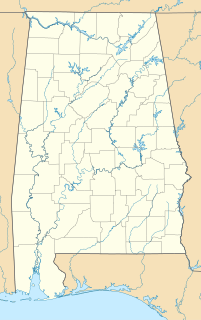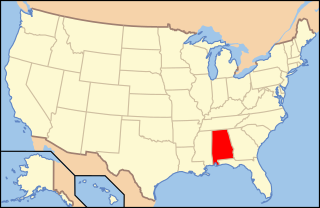
Alabama is a state in the southeastern region of the United States. It is bordered by Tennessee to the north, Georgia to the east, Florida and the Gulf of Mexico to the south, and Mississippi to the west. Alabama is the 30th largest by area and the 24th-most populous of the U.S. states. With a total of 1,500 miles (2,400 km) of inland waterways, Alabama has among the most of any state.

Madison County is located in the north central portion of the U.S. state of Alabama. As of the 2010 Census, the population was 334,811, making it the third-most populous county in Alabama. Its county seat is Huntsville. The county is named in honor of James Madison, fourth President of the United States and the first President to visit the state of Alabama. Madison County covers parts of the former Decatur County.

Huntsville is a city in the Appalachian region of northern Alabama. It is the county seat of Madison County but extends west into neighboring Limestone County and south into Morgan County.

John Williams Walker was an American politician, who served as the Democratic-Republican United States senator from the state of Alabama, the first senator elected by that state.

Alabama Agricultural and Mechanical University is a public historically black land-grant university in Normal, Alabama. Founded in the 1875 as a normal school, it took its present name in 1969. AAMU is a member-school of the Thurgood Marshall College Fund and is accredited by the Southern Association of Colleges and Schools. Alabama Agricultural and Mechanical University Historic District, also known as Normal Hill College Historic District, has 28 buildings and four structures listed in the United States National Register of Historic Places.

Fort Ancient is a Native American earthworks complex located in Washington Township, Warren County, Ohio, along the eastern shore of the Little Miami River about seven miles (11 km) southeast of Lebanon on State Route 350. The site is the largest prehistoric hilltop enclosure in the United States with three and one-half miles (18,000 ft) of walls in a 100-acre (0.40 km2) complex. Built by the Hopewell culture, who lived in the area from the 200 BC to AD 400, the site is situated on a wooded bluff 270 feet (82 m) above the Little Miami. It is the namesake of a culture known as Fort Ancient who lived near the complex long after it was constructed.

Monte Sano State Park is a publicly owned recreation area and mountaintop retreat encompassing 2,140 acres (870 ha) on the eastern portion of the top and slopes of Monte Sano Mountain on the east side of Huntsville, Alabama. The state park has 1930s-era, Civilian Conservation Corps–built rustic cottages, hiking trails and picnic areas with scenic overlooks, and modern campsites. It is managed by the Alabama Department of Conservation and Natural Resources.

St. Stephens is an unincorporated census-designated place in Washington County, Alabama, United States. Its population was 580. Located near the Tombigbee River in the southwestern part of the state and 67 miles north of Mobile, it is composed of two distinct sites: Old St. Stephens and New St. Stephens. The Old St. Stephens site lies directly on the river and is no longer inhabited. It was the territorial capital of the Alabama Territory. Now encompassed by the Old St. Stephens Historical Park, it is listed on the National Register of Historic Places.

The Stagecoach Inn in Newbury Park, California, originally known as the Grand Union Hotel, was used as a resting area for people who traveled from Los Angeles to Santa Barbara. Besides a hotel and stagecoach stop, it has also been used as a post office, church, restaurant and military school. It is California Historical Landmark no. 659 and is listed in the National Register of Historic Places. It played a major role in the development of the stage line transportation network in California. The hotel was also the first business venture in the Conejo Valley.

The Huntsville Depot located on the Norfolk Southern Railway line in downtown Huntsville is the oldest surviving railroad depot in Alabama and one of the oldest in the United States. Completed in 1860, the depot served as eastern division headquarters for the Memphis and Charleston Railroad. It is listed on both the Alabama Register of Landmarks and Heritage and National Register of Historic Places.
The Alabama Register of Landmarks and Heritage, commonly referred to as the Alabama Register, is an official listing of buildings, sites, structures, objects, and districts deemed worthy of preservation in the U.S. state of Alabama. These properties, which may be of national, state, and local significance, are designated by the Alabama Historical Commission. The designation is honorary and carries no direct restrictions or incentives. The register includes properties such as cemeteries, churches, moved properties, reconstructed properties, and properties at least 40 years old which may not normally qualify for listing in the National Register of Historic Places. There are approximately 1421 properties and districts listed on the Alabama Register. Of these, approximately 196 are also listed on the National Register of Historic Places and 5 are designated as National Historic Landmarks.

The following is an alphabetical list of articles related to the U.S. state of Alabama.
The Heart of Huntsville Mall was a shopping mall located in Huntsville, Alabama, United States. It opened in 1961. The mall was demolished in 2007 to make way for a new $150 million mixed-use development called "Constellation."

The following outline is provided as an overview of and topical guide to the U.S. state of Alabama:

Temple B'nai Sholom is a historic synagogue in Huntsville, Alabama. The Reform congregation was founded in 1876, with the current building dedicated November 26, 1899. It is the oldest synagogue building in continuous use in the state. It was listed on the Alabama Register of Landmarks and Heritage on July 29, 1977.

The Gurley Historic District is a historic district in Gurley, Alabama. The town was originally the plantation of John Gurley, who came to Madison County from North Carolina in the 1830s. In 1857, the Memphis and Charleston Railroad built its line through the property, and Gurley constructed a water tank to service the line's locomotives. A post office was established in 1866, at which time only a few families lived in the area. The town incorporated in 1890, and the population immediately began to grow. Industry was attracted to the area by its abundance of lumber; many sawmills, producers of wooden barrels, and the Eagle Pencil Company set up shop near the town. Retail establishments were centered on Joplin Street, however a fire in 1923 destroyed most of the structures. Depletion of the area's timber and the greater influence of neighboring Huntsville drew industry away in the 1920s and 1930s, though despite declining population a new Madison County High School was built in 1936.

The Leech–Hauer House was a historic residence in Huntsville, Alabama. It was built circa 1830 by professional carpenter William Leech. It was built in a transitional style between Federal and Greek Revival. The house was a two-story, L-shaped structure, with a front porch which was later enclosed. John G. Hauer purchased the house in 1904, and it remained a family residence until it was sold to a flower shop in 1974. It was purchased by physician Parker Griffith and his brother in 1977. The house was listed on the Alabama Register of Landmarks and Heritage and National Register of Historic Places in 1978. The house was subsequently demolished, and a modern medical office building was constructed on the site in 1988.
The following is a timeline of the history of the city of Huntsville, Alabama, USA.
The following is a timeline of the history of the city of Tuscaloosa, Alabama, United States.














